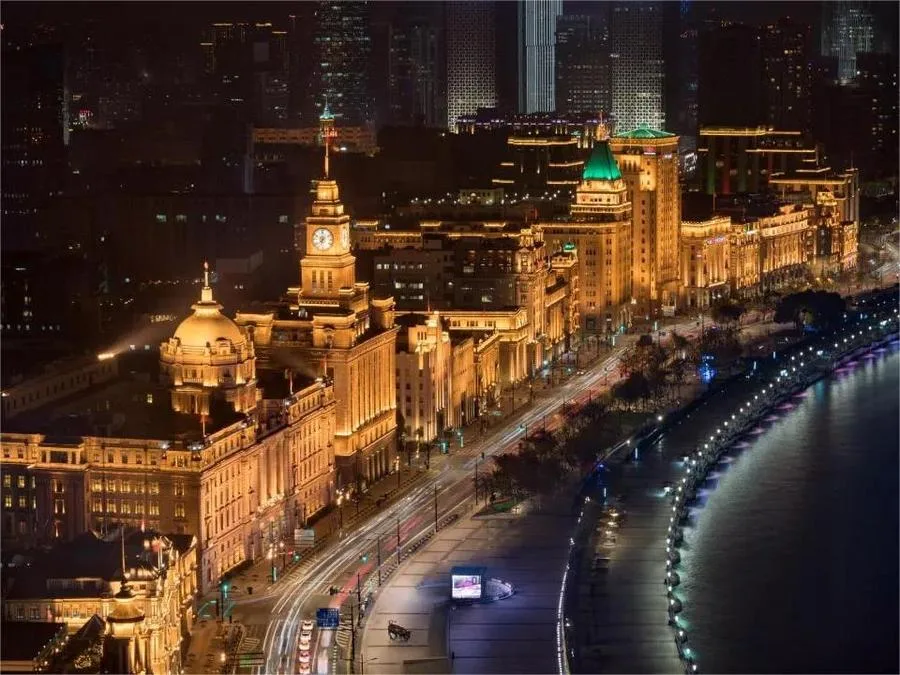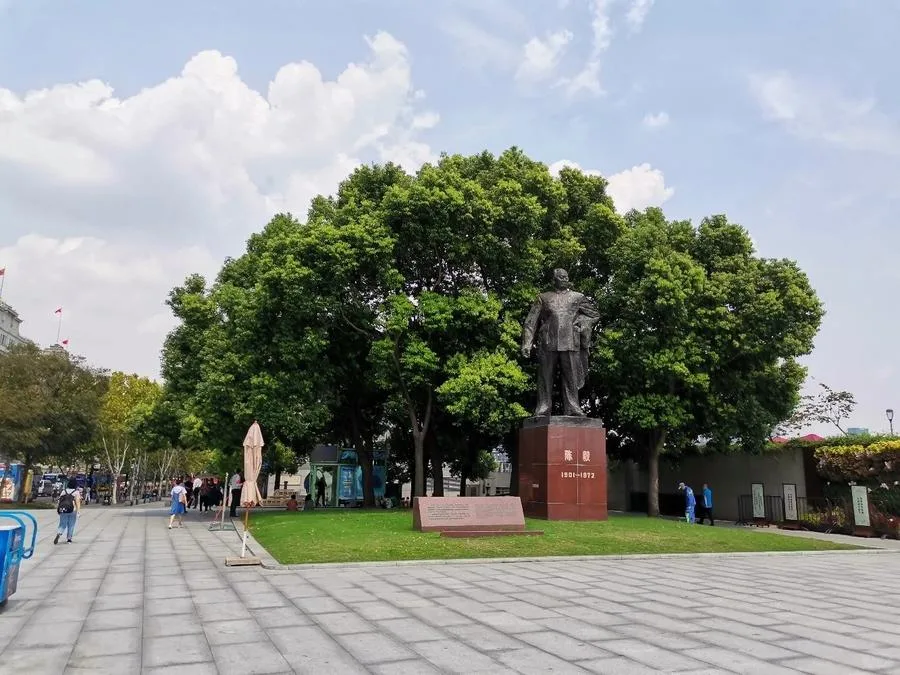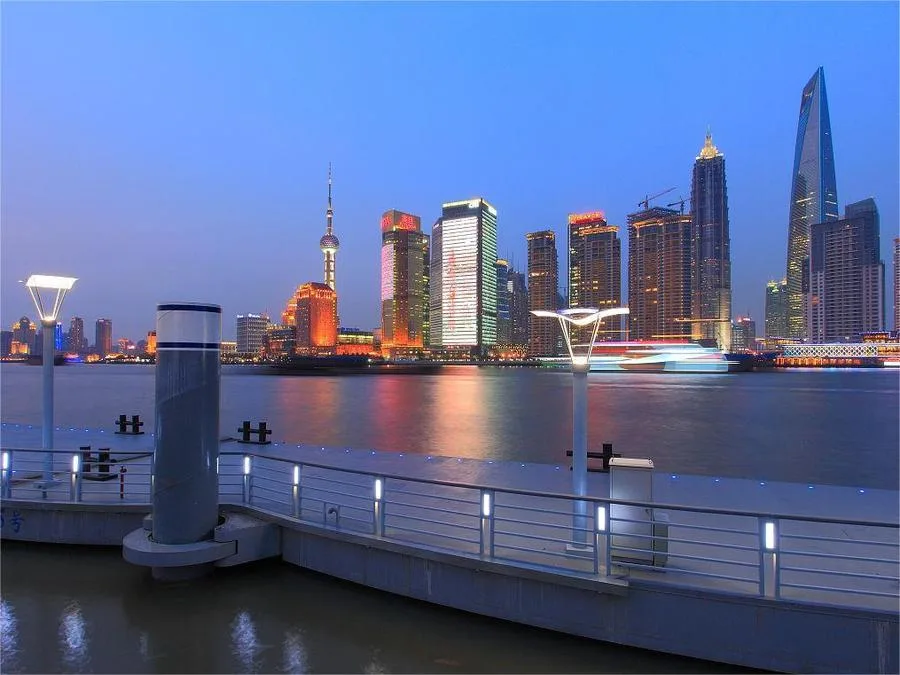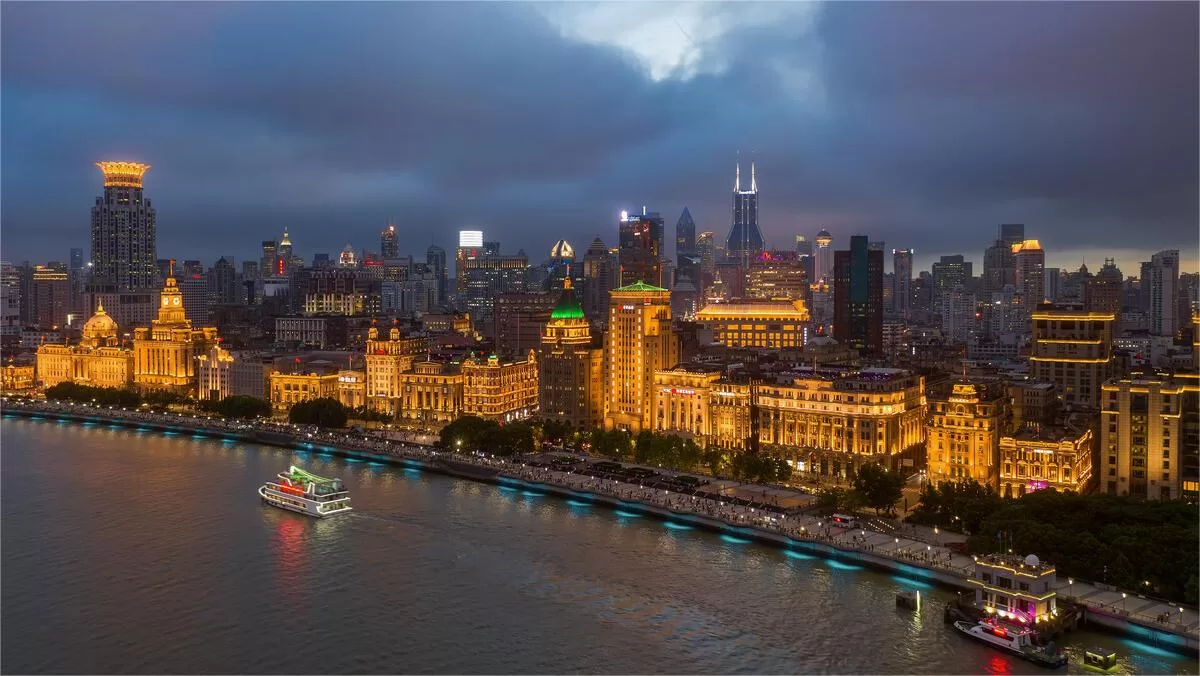The Bund, also known as Waitan (外滩), situated along the bank of the Huangpu River in the Huangpu District of Shanghai, is a cultural and historical quarter of China. Since 1844 (the twenty-fourth year of the Qing Dynasty’s Daoguang reign), this area has been designated as the British Concession, serving as a vivid portrayal of Shanghai’s international settlement and marking the starting point of modern urban development in old Shanghai.
Stretching 1.5 kilometers, the Bund begins at Yan’an East Road in the south and extends to the Waibaidu Bridge over the Suzhou River in the north. Following Shanghai’s establishment as a trading port, foreign banks, trading houses, clubs, and newspapers began to gather here, making the Bund the financial center not only of China but also of the Far East. In August 1943, along with the return of the Shanghai Public Concession to the collaborationist government of the Wang Jingwei regime, the Bund’s century-long concession period came to an end. In 1945, it was officially named Zhongshan East Road during the Republic of China’s thirty-fourth year.
The Bund is adorned with 52 grandiose buildings of diverse architectural styles, collectively known as the “Exhibition of Buildings from All Nations,” showcasing a blend of classical revival architecture. It stands as a significant historical landmark and representative architectural ensemble of modern and contemporary China, earning its status as one of Shanghai’s iconic landmarks. In November 1996, the State Council of the People’s Republic of China listed it as one of the fourth batch of nationally protected cultural relics.
Table of Contents
- Basic Information
- Location and Transportation
- Name Origin of the Bund
- Highlights of the Bund
- Map and Recommended Route
- Vlog about the Bund
- Best Time to Visit the Bund
- Recommended Photography Spots
- Affordable Restaurants with Great Views
- Useful Tips Summarized from Reviews
- Attractions near the Bund
Basic Information
| Tickets | Free |
| Opening time | all-day |
| Landscape lighting | 19.00-23.00 (April 1st– October 31st) 18.00-22.00 (November 1st – March 31st) |
| Estimated length of tour | 1-3 hours |
Location and Transportation
The bund is in the center of Shanghai and is the origin of this oriental magic city. It stretches 1.5 kilometers from Yanan East Road in the south to the Waibaidu Bridge in the north. To its east is the Huangpu River, and to its west are the various historical buildings.
Bus: there are 33 bus routes passing the Bund, including 37, 307, 330, 868, 33, 55, 65, 305, 307, and more. You can find the most appropriate one on Baidu Maps or Google Maps.
Subway: Take subway line 2 or 10, get off at East Nanjing Road Station, and walk to the east for about 10 minutes to reach the Bund.
Ferry: if you are on the east bank of Huangpu River, you can also choose a ferry to get to the Bund. It departs every 12 or 15 minutes and costs 2 RMB.
Name Origin of the Bund
In the late Qing Dynasty, most of the riverbank outside the eastern gate of Shanghai County on the bank of the Huangpu River was a natural sandy area. During low tide, the river water gathered in the center of the riverbed, exposing a vast expanse of sandy land. When the tide rose, the river water covered the sandbank again. The Huangpu River is the main waterway of Shanghai, and due to its width and swift currents, boats traveling against the current had to be pulled by ropes. For hundreds of years, the footsteps of the boatmen formed a winding path on the sandy banks of the Huangpu River, which people called the “rope path,” and this path became the earliest road on the Bund. To the west of the rope path were farmlands, dotted with scattered cottages among the canals and ditches.
In the naming conventions of Shanghai, the upstream of a river is generally referred to as “li” and the downstream as “wai.” Before entering the vicinity of the old county of Shanghai, there was a small tributary called the Shanghai River (now disappeared). Shanghai locals used the outlet of this small river, the Shanghai River, as the boundary. The sandy bank of the Huangpu River upstream was called “Li Huangpu Tan,” or “Inner Bund,” while the sandy bank downstream was called “Wai Huangpu Tan,” or “Outer Bund.”
Highlights of the Bund
Museum of Exotic Buildings

Since the 1940s, when the concessions were seized by countries like Britain and France, the Bund has served as a sovereign area where Western powers operated, managed, and developed the concessions according to their own methods. As trading houses and financial enterprises secured their foothold on the Bund, there was a surge in construction activity, resulting in the erection of grandiose buildings. Many of the structures on the Bund have undergone three or more reconstructions.
In the 20th century, with the advancement of architectural technology and the growth of economic strength, the Bund witnessed the emergence of multi-story and high-rise buildings, featuring a diverse range of architectural styles. These styles include British classical, British neoclassical, British Renaissance (Asia Building, formerly Shanghai Metallurgical Design Institute), Shanghai Club (now the Dongfang Hotel), the Shanghai Pudong Development Bank Building (formerly the HSBC Building), and the Chartered Bank Building (now the Foreign Trade Bureau Building). Additionally, there are French classical, French residential, Gothic, Baroque, modern Western, Indo-Saracenic, eclectic, and Sino-Western hybrid styles, creating a landscape where architectural styles from around the world coexist.
Waibaidu Bridge (Garden Bridge)

The Waibaidu Bridge has undergone three generations of construction. According to historical records, the original Waibaidu Bridge was a wooden structure, built in the sixth year of the Xianfeng reign of the Qing Dynasty (1856). It featured a movable bridge deck in the middle, which had to be raised to allow boats to pass through. This bridge was jointly funded by Britons working for the Jardine Matheson & Co. at the time, including a man named Wales, hence its name, “Wales Bridge.”
The second generation of the Waibaidu Bridge was constructed to the left of the “Wales Bridge” in the twelfth year of the Tongzhi reign of the Qing Dynasty (1873). Due to its proximity to the Bund Park, it was known as the “Garden Bridge” to the British at the time, while locals simply referred to it as the “Outer Ferry Bridge.” Over the following decades, due to linguistic misinterpretations, it gradually came to be pronounced as “Waibaidu Bridge,” a name that stuck. Consequently, tolls for crossing the bridge were abolished, and the Wales Bridge was dismantled by the Municipal Engineering Department.
In the thirty-third year of the Guangxu reign of the Qing Dynasty (1907), the Municipal Engineering Department of the concession decided to build a new bridge, leading to the construction of the third-generation steel-structured Waibaidu Bridge, which remains in use to this day. This iconic bridge has not only facilitated transportation across the Suzhou River but has also become a symbol of Shanghai’s history and development.
Chenyi Square

Chen Yi Square is located on the Bund, outside Nanjing East Road, in Shanghai. At the center of the square stands a statue of Chen Yi, the first mayor of Shanghai under the People’s Republic of China. The bronze statue of Chen Yi faces south and is 5.6 meters tall, mounted on a pedestal made of polished red granite, standing 3.5 meters high. The statue depicts Chen Yi in a typical posture during his inspection tours.
To the south of the Chen Yi statue is the Wishing Fountain, featuring a modern fountain with a square outer perimeter and an elliptical inner ring. A century ago, this site was adorned with a bronze statue commemorating Sir Edward Belcher, the British colonial governor in China. Today, Chen Yi Square serves as a tribute to Chen Yi’s contributions to the city of Shanghai and stands as a landmark along the bustling Nanjing East Road and the historic Bund waterfront.
The Bund Sightseeing Tunnel

The Bund Sightseeing Tunnel is the first pedestrian tunnel crossing the Huangpu River in Shanghai. Its Pudong entrance is located near the west side of the Oriental Pearl TV Tower, while the Puxi entrance is situated north of Chen Yi Square on the Bund. Completed at the end of 2000, it is China’s first pedestrian tunnel crossing the Huangpu River.
The tunnel spans 646.70 meters in length, with underground structures on both sides consisting of three levels, partially four, totaling nearly 17,500 square meters of built-up area. Equipped with an unmanned automated control system, the Bund Sightseeing Tunnel operates with twelve transparent-walled sightseeing cars, shuttling tourists between the Pudong and Puxi sides of the Huangpu River. These cars travel at a speed of 3 meters per second, completing the journey in just 5 minutes, and have a capacity to transport up to 5000 passengers per hour.
Huangpu River Cruise

It is wonderful to appreciate the view of the Bund from the bank. Still, you will get a completely different experience from the ship, which allows you to enjoy the exotic buildings from another angle, feel the breeze from the river, and, most importantly, avoid the crowd.
Many companies provide the river cruise services. Their prices vary according to the boat’s size and the cruise’s time. But generally, the prices are around 100 RMB, and you should book the ticket at least 2 hours in advance.
Lujiazui Financial Center

Right across Huangpu River from the bund is the Lujiazui Financial Center, which houses fancy hotels, conference centers, headquarters of many banks, and other skyscrapers, namely the representation of contemporary Shanghai. They form a stark contrast with the various buildings on the bund. If you are familiar with China’s modern history, this sight will stir your thoughts and make you wonder what this place will be like a century later.
Huangpu Park

Huangpu Park, located at No. 28 Zhongshan East 1st Road, with its eastern boundary along the Huangpu River, southern adjacent to the Bund greenbelt, western border along Zhongshan East 1st Road, and northern connecting to the Wusong River (Suzhou River), stands as Shanghai’s earliest European-style garden. Established in the seventh year of the Tongzhi reign of the Qing Dynasty (1868), it serves as a witness to the vicissitudes of the Bund over the past century.
The focal point of Huangpu Park is the Monument to the People’s Heroes, situated in the northeast corner where the Huangpu River meets the Suzhou River. Standing at 60 meters tall, the monument symbolizes the heroes sacrificed during the Opium War, May Fourth Movement, and Liberation War, resembling three surging waves merging into the sky.
The park features embankments along both the eastern and northern sides, with the Suzhou River embankment stretching 80.7 meters and the Huangpu River embankment 137 meters, each 10 meters wide. The sculpture “Tide of the Pu River” is located in the southern flowerbed, facing the park’s entrance, depicting a warrior waving a flag, symbolizing the people breaking free from the shackles of the old society.
Sixteen Pu (Shiliupu)

Sixteen Pu, formerly known as “Bao Dai Gate,” lies outside Xiaodongmen. To the east, it faces the Huangpu River, while to the west, it borders Danfeng Road. Its southern reach extends to Laotaiping Alley, and to the north, it stretches to Longtan Road. Historically, the southern side extended to Wanyu Wharf Street, serving as Shanghai’s aquatic gateway. The wharf was constructed by the American Flag Chang Steamship Company in the first year of the Tongzhi reign of the Qing Dynasty (1862) and was initially named Sixteen Pu Wharf during the Xianfeng and Tongzhi periods. It was later renamed Nan Zhan Wharf, Roosevelt Wharf, Jiangxi Wharf, among others, until it was reverted to its original name, Sixteen Pu Wharf, after liberation. In 1982, the warehouse of the Merchants’ Warehouse established by Li Hongzhang was demolished, and the Sixteen Pu New Passenger Station was constructed on the original site.
Situated between the Waibaidu Bridge and Lupu Bridge in the middle of the Huangpu River’s golden waterway, Sixteen Pu features an S-shaped bend in the river. Its waterfront platform spans 730 meters, offering a 270-degree panoramic view. Visitors can enjoy vistas of the Bund’s Exhibition of Buildings from All Nations, as well as iconic landmarks such as the Oriental Pearl Tower, Jin Mao Tower, Shanghai World Financial Center, and Shanghai Tower. Below the waterfront platform is a sunken plaza spanning 20,000 square meters and divided into three levels. Entertainment and dining facilities are located on the first and second levels, closely connected to the Sixteen Pu Tourist Distribution Center and the Huangpu River Cruise Terminal.
Map and Recommended Route

Start your journey at The Bund, Shanghai’s iconic waterfront promenade, known for its stunning skyline views and historical significance. From The Bund, head to Waibaidu Bridge, a historic steel bridge offering picturesque views of the Huangpu River. Continue your walk to the World Guest Hall, a popular spot for visitors to soak in the grandeur of Shanghai’s waterfront.
Next, take a break at Manner (Guoke Binjiang), a riverside café perfect for a refreshing drink while enjoying the scenic views. After your break, proceed to the Beiwaitan Riverside Greenway, a lush and serene pathway ideal for a leisurely stroll.
From there, head to the Gongping Road Ferry Terminal, where you can take a ferry across the river for just 2 yuan. The ferry ride offers a unique perspective of the city’s skyline. Disembark at the Taitongzhan Ferry Terminal and make your way to the Oriental Pearl Tower, one of Shanghai’s most famous landmarks.
Nearby, visit the Pudong Art Museum, which showcases contemporary art in a modern setting. Continue to the Xiaolujiazui Scenic Area, known for its stunning views and vibrant atmosphere. Here, you can explore Tianshui Lian, a beautiful spot offering tranquility amidst the bustling city.
Next, head to the Dongchang Road Ferry Terminal for another 2 yuan ferry ride, providing expansive views of the cityscape. This ride takes you to the Jinying East Road Ferry Terminal, where you can conclude your journey.
Time Planning: The entire route is approximately 5 kilometers long and can be completed in about 3-4 hours at a leisurely pace.
Tips
- The Bund and the Oriental Pearl Tower are illuminated from 7:00 PM during the months of May to September. The night scenery is particularly stunning during this time.
- For the best experience, plan to arrive at the Gongping Road Ferry Terminal by 6:30 PM. The ferry ride offers open views, and if the weather is good, you can witness a spectacular sunset, making for an unforgettable experience.
Vlog about the Bund
Best Time to Visit the Bund
The best time to visit The Bund is during spring (March to May) and autumn (September to November). During these seasons, the weather is pleasant, making it ideal for strolling and admiring the architectural beauty. The Bund is especially enchanting at night when the lights illuminate the skyline.
In spring, the mild climate is perfect for evening walks along the river, while autumn’s clear and crisp weather provides the best conditions for appreciating the stunning buildings. The lighting times vary by season: in summer and autumn, the lights are on from 7:00 PM to 11:00 PM; in winter, from 5:00 PM to 9:00 PM; and in spring, from 6:00 PM to 11:00 PM. On important holidays, the lights stay on until midnight.
Recommended Photography Spots
- Intersection of Jiujiang Road and Sichuan Middle Road: This spot offers a classic view of The Bund’s skyline, perfect for capturing the bustling energy and architectural grandeur.
- Beiwaitan Riverside Green Land “Small Egg”: Located in the green area of North Bund, this unique structure provides a scenic backdrop with the river and modern buildings.
- North Bund Platform (near the World Guest Hall): An elevated platform offering panoramic views of The Bund and Pudong skyline, ideal for wide-angle shots.
- 7th Floor of Samei Building: Enjoy a drink while capturing stunning views from this high vantage point, providing a great perspective of The Bund.
- Waibaidu Bridge: A historic steel bridge offering picturesque views of the Huangpu River and The Bund, perfect for both day and night photography.
- Intersection of Yuanmingyuan Road and South Suzhou Road: This spot provides a unique angle of The Bund with the historic charm of Yuanmingyuan Road.
- Union Building: Capture the grandeur of this historic building with its European-style architecture.
- Zhapu Road Bridge: Offers great views of the river and the bustling city life, ideal for capturing the essence of Shanghai.
- Southeast Gate of Shanghai Postal Museum: The historic architecture of the museum combined with views of the river makes this a prime photography spot.
- Intersection of Dongchangzhi Road and Lüshun Road: A lesser-known spot offering unique views of the city and river.
- Intersection of Liyang Road and Changzhi Road: Provides interesting urban scenery and a quieter atmosphere for photography.
- Intersection of Jiulong Road and Changzhi Road: Another great spot for capturing the vibrant city life and unique architectural details.
- The Bund Origin 33 – Union Church: A historic church providing a picturesque and serene backdrop.
- Intersection of North Suzhou Road and Waibaidu Bridge: Offers excellent views of the bridge and surrounding areas, perfect for both close-up and wide-angle shots.
- 1st Floor of Samei Building: Capture street-level views and the historic charm of The Bund area.
- Intersection of Sichuan North Road and North Suzhou Road: A great spot for capturing the intersection of modern and historic Shanghai.
- Intersection of Sichuan Middle Road and Dianchi Road: Provides interesting urban landscapes and a quieter atmosphere for photography.
- Gongping Road Ferry Terminal: A fantastic spot to capture the river, The Bund skyline, and ferries in action, especially at sunset.
Affordable Restaurants with Great Views
| No. | Restaurant Name | Address | Highlights | Special Offers |
|---|---|---|---|---|
| 1 | ROOF P.M. Modern Dining | Rooftop of Pudong Art Museum, Q RT Floor | Drink for 19.9 RMB, stunning sunset views | None |
| 2 | POP Terrace Restaurant | 7th Floor, Three on the Bund | Afternoon tea and drinks, panoramic views of The Bund | None |
| 3 | Kathleen’s Waitan | 453 Waima Road, Old Dock No. 1, Q | Pleasant evening scenery | 298 RMB afternoon tea for two |
| 4 | REi.FLOWER COFFEE BAR | 234 North Suzhou Road | Views of the Oriental Pearl Tower, perfect for coffee and drinks | None |
| 5 | eat n work (Super Brand Mall) | 168 Lujiazui | Beautiful terrace, affordable coffee and lunch | None |
| 6 | CASANOVA Italian Restaurant (The Bund) | 6 The Bund | Unique terrace photo spot, breakfast or lunch | 148 RMB single brunch |
| 7 | BAKTRO mit laib&seele (North Bund) | No. 1 Platform, Riverside Green Land | Prime location with views of Lujiazui | 58 RMB weekday tea set for one |
| 8 | Cocina 19 Spanish Restaurant (The Bund) | 19 Fuzhou Road | Authentic Spanish cuisine, elegant setting | 68 RMB single afternoon tea |
| 9 | Canton Table | 5th Floor, Three on the Bund, Q | Expansive views, perfect for dates | 228 RMB lunch |
| 10 | MUSE PENTHOUSE | 65th Floor, World Trade Tower | Sweeping views of Pudong and North Bund, rooftop bar | None |
Useful Tips Summarized from Reviews
Avoid the Crowds on Nanjing East Road: The pathway leading from Nanjing East Road to the Bund is typically crowded, making it difficult to move around freely. To bypass the crowds, opt for the adjacent Dianchi Road, where you’ll encounter significantly fewer people, allowing for a more relaxed stroll.
Skip the Bund Sightseeing Bus: Waiting in line for the Bund sightseeing bus, especially for the open-top deck (only the back half of the second floor lacks a roof), can be time-consuming, often taking up to two hours. Many visitors find it not worth the wait due to the crowds and limited views. Instead, explore the area on foot or consider other modes of transportation.
Enjoy the Night Scenery: The Bund’s nighttime scenery is a must-see experience. However, you don’t need to spend a lot on a sightseeing ferry to enjoy it. Opt for a budget-friendly option by taking a ferry from Dongchang Road Ferry Terminal to Jinling East Road Ferry Terminal for only 2 yuan. This short trip will allow you to enjoy the enchanting night view of the Huangpu River.






The rainy day at the Bund in Shanghai really looks like London…
A stroll along the Bund in Shanghai at night. The weather is really nice today. There are a lot of people, but it’s still very pleasant to walk. Shanghai is a beautiful city.
The weather is great! There are a lot of people at the Bund in Shanghai! The scenery is really beautiful at night, and the evening breeze from the Huangpu River is so refreshing!
The tulips at the Bund have bloomed!! How romantic!
The buildings of the Bund and the Oriental Pearl Tower turn off their lights at 10 PM. However, at this moment, the lights in various office buildings remain brightly lit!